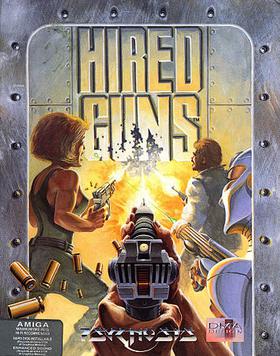
Hired Guns is a role-playing video game developed by DMA Design for the Amiga and IBM PC compatibles and published by Psygnosis in 1993. In the year 2712, players control a team of four outlaw mercenaries, chosen from a pool of twelve, attempting to destroy illegal bio-engineered organisms using a thermonuclear explosion. The game shows four simultaneous first-person perspective viewpoints and allows up to four players to play together. Players must manage their characters' inventory and carrying capacity, and adapt to various environmental challenges like underwater areas.
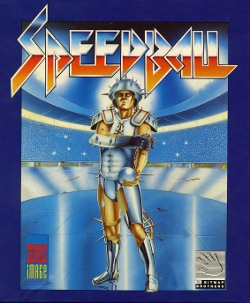
Speedball is a 1988 video game based on a violent futuristic sport that draws on elements of handball and ice hockey, and rewards violent play as well as goals.

Wonder Boy in Monster Land, known by its original arcade release as Wonder Boy: Monster Land, is a platform video game developed by Westone Bit Entertainment and released by Sega in Japanese arcades in 1987 and for the Master System in 1988, with a number of other home computer and console ports following. The game is the sequel to the 1986 game Wonder Boy and takes place eleven years after the events in the previous game. After enjoying over a decade of peace on Wonder Land following the defeat of the evil King by Tom-Tom, later bestowed the title "Wonder Boy", a fire-breathing dragon called the MEKA dragon appeared; he and his minions conquered Wonder Land, turning it into "Monster Land". The people, helpless due to their lack of fighting skill, call for Wonder Boy, now a teenager, to destroy the monsters and defeat the MEKA dragon. Players control Wonder Boy through twelve linear levels as he makes his way through Monster Land to find and defeat the MEKA dragon. Players earn gold by defeating enemies and buy weapons, armor, footwear, magic, and other items to help along the way.

Laser Squad is a turn-based tactics video game, originally released for the ZX Spectrum and later for the Commodore 64, Amstrad CPC, MSX, Amiga, Sharp MZ-800 and Atari ST and PC computers between 1988 and 1992. It was designed by Julian Gollop and his team at Target Games and published by Blade Software, expanding on the ideas applied in their earlier Rebelstar series. Laser Squad originally came with five mission scenarios, with an expansion pack released for the 8-bit versions, containing a further two scenarios.
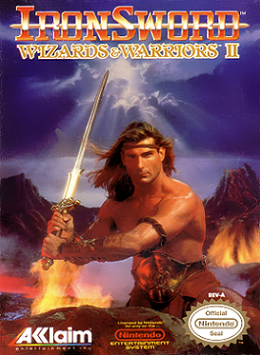
Ironsword: Wizards & Warriors II is a platforming action-adventure video game for the Nintendo Entertainment System (NES) developed by UK-based company Zippo Games, a subsidiary of Rare. The game was published by Acclaim and released in North America in December 1989 and in Europe on March 27, 1991. It is the sequel to Rare's 1987 title Wizards & Warriors. In Ironsword, the player controls the knight warrior Kuros as he ventures in the land of Sindarin. He must defeat the evil wizard Malkil, who has assumed the elemental forms of Earth, Wind, Fire, and Water. Kuros must collect the parts of and assemble the legendary "IronSword" in order to defeat Malkil, who resides at the top of IceFire Mountain.

Untold Legends: Brotherhood of the Blade is a launch title for the Sony PSP handheld video game system, developed by Sony Online Entertainment. It is a third person action role-playing game in which the player can complete various quests for money and items. Untold Legends can be played cooperatively with up to four other players via Ad Hoc.

Wizkid: The Story of Wizball II is a humorous action game for the Amiga, Atari ST, and IBM PC compatibles. It was developed by Sensible Software and published by Ocean Software in 1992. Wizkid is the sequel to 1987's Wizball.

Powermonger is a real-time strategy video game developed by Bullfrog Productions and published by Electronic Arts. Originally released in 1990 for the Amiga and Atari ST, it was derived from the Populous engine but presented using a 3-dimensional game map.

Fiendish Freddy's Big Top o' Fun is a video game developed by Gray Matter under developer Chris Gray and published in 1990 by Mindscape. It originally appeared on the 16-bit Atari ST, IBM PC and Commodore Amiga, before later being converted to the ZX Spectrum, Commodore 64, Amstrad CPC. The Commodore 64 version was included on cartridge bundled with the Commodore 64 Games System.
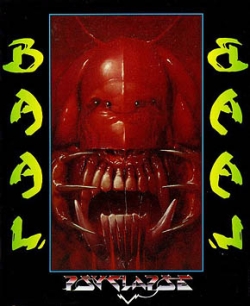
Baal is a platform-based shoot 'em up video game published in 1988 by Psygnosis. The player takes on the role of a "Time Warrior" sent into the recesses of hell to recover pieces of "The War Machine", which has been stolen by the evil minion Baal. The game was ported to MS-DOS by Tim Ansell of The Creative Assembly.
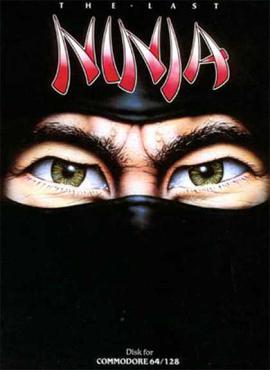
The Last Ninja is an action-adventure game originally developed and published by System 3 in 1987 for the Commodore 64. It was converted to the Apple IIGS, MS-DOS, BBC Micro and Acorn Electron in 1988, the Apple II series in 1989, the Amiga and Atari ST in 1990, and the Acorn Archimedes in 1991.

Bonk's Adventure, known as PC Genjin in Japan, PC Kid and B.C. Kid in Europe, is a scrolling platform game developed by Red Company and Atlus and released in 1989 in Japan and 1990 in North America for the PC Engine/TurboGrafx-16. The Japanese title PC Genjin is a play on the system's original name, PC Engine, with the European title PC Kid similarly referencing the system's name. The first game in the Bonk series, it was followed by two more games for the TurboGrafx-16 before branching out to other platforms.
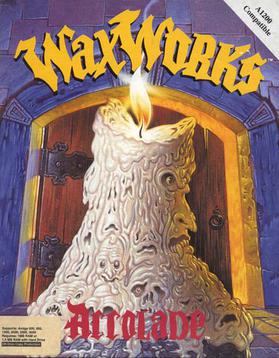
Waxworks is a horror-themed first-person dungeon crawl video game developed by Horror Soft and released in 1992 for Amiga, Macintosh, and DOS.

Bill's Tomato Game is a puzzle game for the Amiga, designed by Bill Pullan and published by Psygnosis in 1992. The artwork is by Lee Carus-Westcott and the music by Mike Clarke. The concept of the game is very similar to Sierra's The Incredible Machine.

Elvira II: The Jaws of Cerberus is the second game in the Elvira series of horror adventure/role-playing video games. It was developed by Horror Soft and published by Accolade in 1992. The game is a sequel to 1990's Elvira: Mistress of the Dark. It was followed by Waxworks, which can be considered its spiritual sequel.
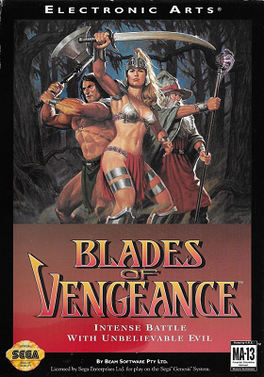
Blades of Vengeance is a platform game developed by Beam Software and published by Electronic Arts for the Mega Drive/Genesis. One or two players can select one of three fantasy warriors to fight through a large range of platform levels in order to defeat the forces of darkness.
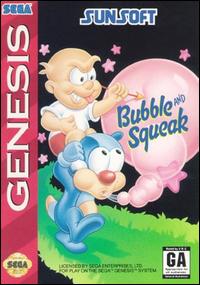
Bubble and Squeak is a platform game published for the Amiga in 1994 by Audiogenic Software. It was developed by Fox Williams under the name Barney & Clyde, and they ported it to the Sega Genesis for which it was published by Sunsoft under license from Audiogenic. The game is a childlike sci-fi fantasy platform game in which players control a little human boy named Bubble along with recent alien acquaintance Squeak. The platform levels are separated by brief underwater scrolling shooter bonus segments.

Cloud Kingdoms is a puzzle game published by Millennium Interactive for the Amiga, Atari ST, Commodore 64, and MS-DOS in 1990. The player controls Terry, a green bouncing sphere, on a quest to recover his magic crystals that have been stolen by Baron von Bonsai. To do so, he must travel through the eponymous Cloud Kingdoms, avoiding enemies and hazards while collecting all of the crystals within the game's time limit. The game was developed by Dene Carter at Logotron, with sounds and music composed by David Whittaker.

Last Ninja 2: Back with a Vengeance is an action-adventure video game developed and published by System 3 for the Commodore 64, ZX Spectrum and Amstrad CPC in 1988 as a sequel to the 1987 game The Last Ninja. The Acorn Electron, BBC Micro, 1990: Amiga, Atari ST, MS-DOS and NES ports followed in 1989. The NES version of the game was named simply The Last Ninja. In 1990, the Last Ninja Remix edition of the game was re-released for 8-bit systems.

Skull & Crossbones is a pirate-themed beat 'em up developed by Atari Games and released as an arcade video game in 1989. Developer Tengen ported the game to the Amiga, Amstrad CPC, Atari ST, Commodore 64, MS-DOS, Nintendo Entertainment System, and ZX Spectrum.




















